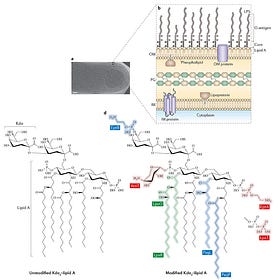Endotoxin Aggregate Zeta Potential and Direct TEM Observation with Zinc Complex Fluorescence
Clever research from Japan detects Picomolar Endotoxin in the presence of chemicals known to inhibit the Horseshoe Crab Blood LAL test.
Thanks to my friend OpenVAET who found a recent paper on a much improved, fast and effective test for bacterial Endotoxin with a detection limit of 11 Picomoles per Litre.
Takahashi Hayashita and coworkers1 have developed a method using a Zinc complex Zn-dpa-C2OPy where the Zinc atom combines with an organic ligand made from 2,2'-dipicolylamine and 1-hydroxypyrene. The Zinc complex binds a number of Endotoxin (Lipopolysaccharide, LPS) strands together, affecting their Zeta Potential and enabling direct observation of the aggregates via Transmission Electron Microscopy. They experimented with a number of Zinc compounds.
The supplementary file for their paper shows the effect of Zinc ions altering the Zeta Potential of the Endotoxin (Fig. 7) and at (Fig. 8c) the 10 micromolar Endotoxin aggregates become easily visible. Note the scale bar is 500 nanometres.
They successfully performed this analysis in the presence of 5 millimolar HEPES (4-(2-HydroxyEthyl)-1-PiperazineEthaneSulfonic acid), which is known to interfere with the LAL test.2
Weak response to Lipid A
The main paper shows in Figure 3 that this new technique has low sensitivity for the most toxic component of the jabs, Lipid A.
The authors state:
A selectivity assay was conducted by adding biologically important compounds that could coexist with LPS in water or are similar in structure to LPS (i.e., phospholipids, negatively charged molecules, or polysaccharides), instead of LPS (Figure 3a). Phosphate (Pi), pyrophosphate (PPi), triphosphate (Tri), adenosine monophosphate (AMP), adenosine diphosphate (ADP), and adenosine triphosphate (ATP) are representative phosphate derivatives existing ubiquitously in biological samples.29−31 Zndpa-C2OPy showed the highest selectivity for LPS among all the examined compounds. The enhancement of F477/F384 by lipid A was expected because lipid A is a toxic phosphate lipid component of LPS; this also meant that the chemosensor was able to recognize the toxic component of LPS. In addition, lipid A alone was not sufficient to obtain a strong response like LPS alone, suggesting that the unique structure of LPS, which is composed of sugar chains and lipid A, was selectively recognized, judging from the results of galactose, curdlan, and lipid A.
The new method is currently not as sensitive as Mass Spectrometry3 or electronic sensors4 under development, however it might benefit from advanced photon detectors in the future.
Hiroshi Kimoto, Moeka Takahashi, Masakage Masuko, Kai Sato, Yuya Hirahara, Masamitsu Iiyama, Yota Suzuki, Takeshi Hashimoto and Takashi Hayashita. 2023. High-Throughput Analysis of Bacterial Toxic Lipopolysaccharide in Water by Dual-Wavelength Monitoring Using a Ratiometric Fluorescent Chemosensor. https://pubs.acs.org/doi/10.1021/acs.analchem.3c01870
AstraZeneca Endotoxin Test Meaningless
In a previous article I have shown that AstraZeneca was withdrawn because it was killing a higher proportion of people that Pfizer or Moderna. Delving further, I now find that the complete conspiracy of suppression of AstraZeneca Endotoxin measurements is probably hiding embarrassing deadly facts.
FDA detected Endotoxin by Mass Spectrometry
As mentioned in earlier posts Gram Negative Bacterial Cell fragments known as Endotoxin and its supertoxin Lipid A are deliberately incorporated into the Pfizer Covid19 and Novavax jabs and are also present in AstraZeneca, Janssen, Moderna jabs because no technology was applied to remove them.
Graphene Oxide, Gold and Organometallic Ferrocene make sensitive Endotoxin Detector
In 1980 I had the pleasure of meeting Nobel Prize winner Professor Sir Geoffrey Wilkinson who made Ferrocene, a “sandwich molecule”, where two carbon pentagons bond to an Iron atom. Wilkinson was a supervisor of my PhD supervisor Ron Dickson. I had made Ferrocene as an undergraduate experiment and went on to make new similar molecules of the Platinum Gr…








